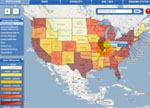Apportionment is the process of dividing the seats in the House of Representatives among the 50 states based on the population figures collected during the decennial census. The number of seats in the House has grown with the country. Congress sets the number in law and increased the number to 435 in 1913. The Constitution set the number of representatives at 65 from 1787 until the first Census of 1790, when the it was increased to 105 members.
But how does apportionment actually work? Through animation, the U.S. Census Bureau helps explain how the apportionment formula is used to ensure equal representation for all, just like the Founding Fathers planned.
Running time: 1:52










